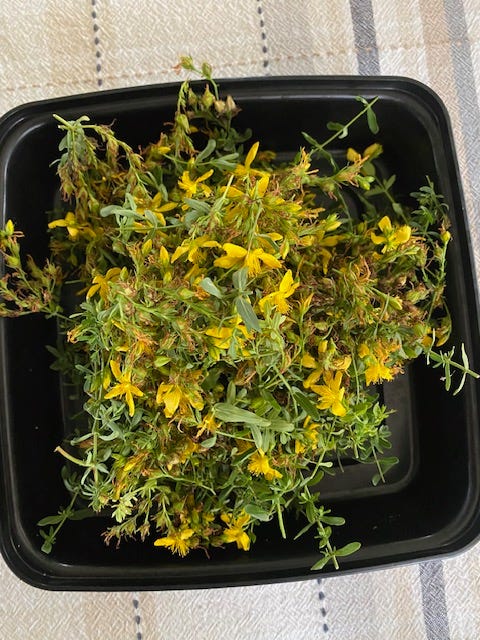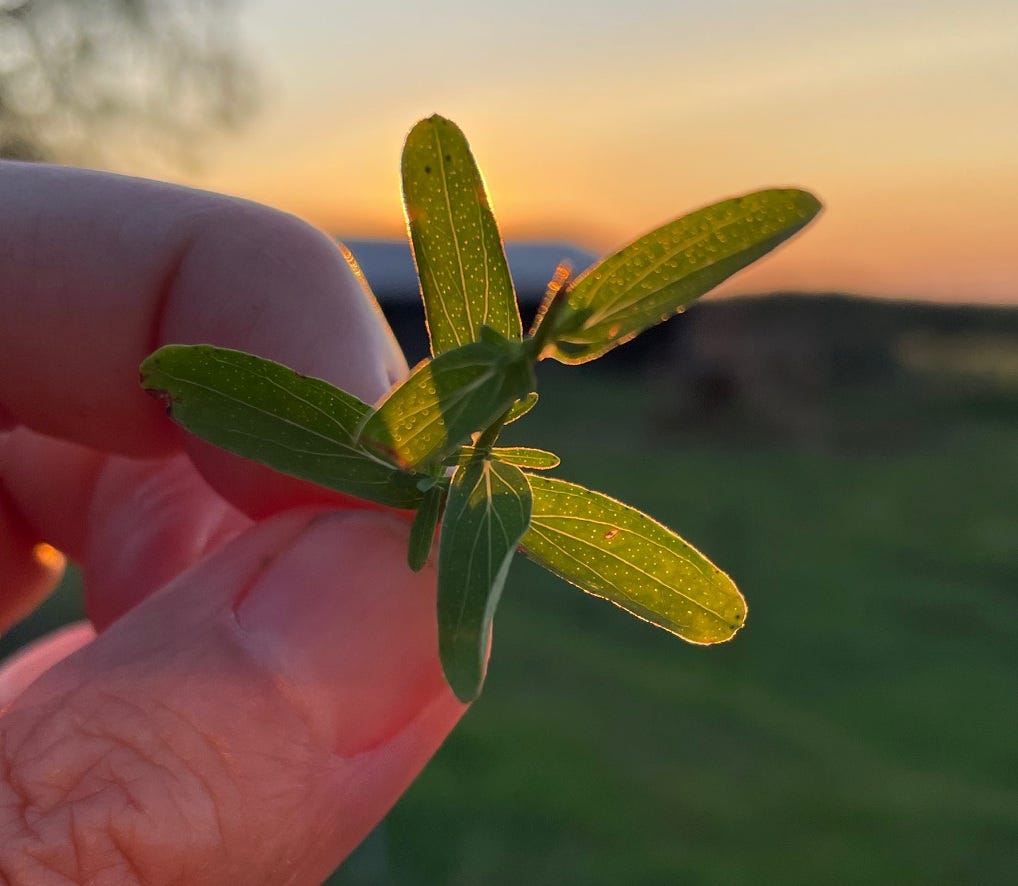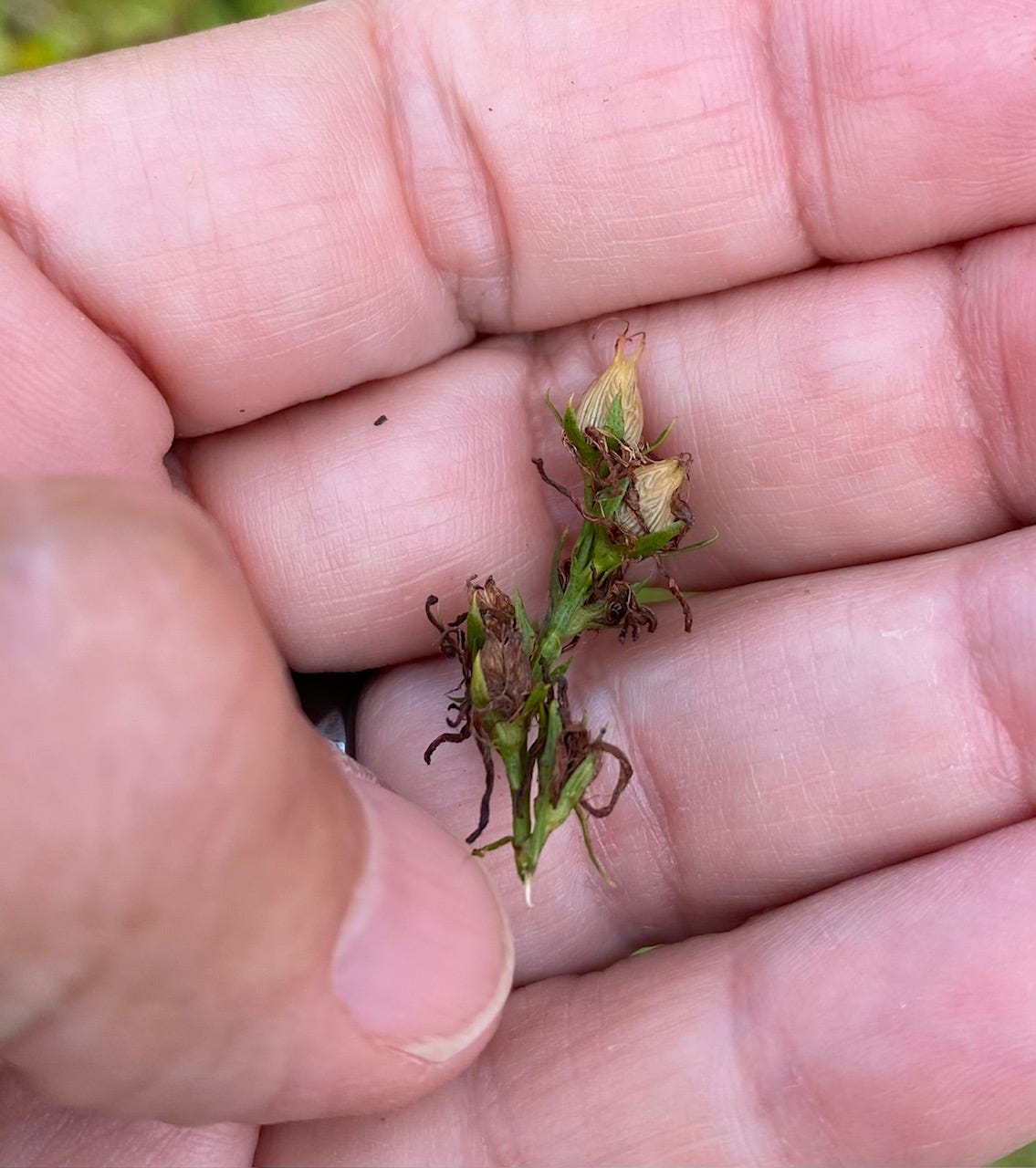At Weedom, the summer is all about new grandkids and a new season of life. This isn't optimal for sheer output at the SubStack, but most of you are equally busy during this time of year, and perhaps have a backlog reading. We're gazing at the St. John's wort as it pumps out blooms that we've been too busy to collect and extract until now. This herb is extremely useful topically, even for those who don't think they can take it internally for the various CNS benefits. Topical use of this herb can focus the activity on a particular target, and reduce the potential for side effects and drug interactions. So keep oil infusions and liniments in mind, as well as tinctures and teas.
Among the Hypericum species, you mainly will want the weed with the ‘holes’ in the leaves... Hypericum perforatum.
Those dots, corresponding to pellucid secretory glands, are closer to windows than actual holes. H. perforatum is the species with the most excellent chemistry found in the blooms, buds and leaves. Gather some and tincture it fresh. You can wilt the upper parts of this flowering plant, and infuse them into oil. There are arguments as to how long the dried plant keeps its potency, but numerous reliable sources find useful activity remaining in the dried plant material. Storing it well matters, and more recently dried material retains activity that can be extracted into teas and tinctures. Some report that the dried material does not extract well into oils, and that the fresh material has to be macerated or bruised before such extraction. (At weedom, we have not yet done oil extractions of St. John’s wort.) You'll know you're on the right track when you see a deep red color forming in your extract.
The bloom time of this member of the family Hypericaceae, (or Clusiaceae) runs from May thru August, depending on where you are. We want you to have a chance to look for this plant before the blooms are gone. Even after blooms disappear you can think about seeds and transplants to grow St. John’s wort where you can easily reach it. This perennial blooms in the second year of life, starting in June near the summer solstice at weedom, and is still blooming now, at the end of July. Plants may present as a single branched stem when they’re young, or when crowded, and may mature into a bushy shape up to 2 feet wide and 2.5 feet high.
One of about 400 species in the Hypericum genus, St. John’s wort is native to Europe, and parts of Asia and Africa. This species traveled, likely with the dandelions, and has had near similar success in taking over most of North America. It thrives in USDA zones 3-9, with or without the help of herbalists who plant it on purpose. We find it to be happiest in partial shade at our latitude, because that’s where it pops up, unbidden. but further north it probably prefers all day sun. St. John’s wort is perennial here, spreading laterally by rhizomes, and by reseeding. Each plant may produce a hundred thousand ultra fine seeds which, like chamomile and other such plants, require sun exposure to germinate. The seeds are claimed to survive from 10-30 years in the soil.
Leaves emerge oppositely from stems in sessile fashion (no petioles). The stems themselves also branch oppositely from a main stem. Older, hairless stems are round in cross section, but younger stems may have ridges. Leaves are oblong, hairless and may reach 1 inch (2.5 cm) in length x 0.3, (0.8 cm) inch wide. Tiny translucent white dots can be seen on the leaves if you hold them up to the light, which are the hallmark of this plant, distinguishing it from related species. The lower surface of the leaves may show black dots, which are oil containing glands, along the margins.
Flowers have 5 petals, 5 sepals and both male and female parts. Like the leaves, they may have black dots on their margins. Flowers are about an inch plus, (3 cm) in diameter.

The 3 celled seed capsule has a rounded base, tapering to a point at the tip. The numerous, tiny, oblong, black seeds within each cell have a pitted surface. Their massive numbers caused widespread dispersal of St. John’s wort, which may invade pasturelands, and cause toxicity to livestock if eaten in quantity. Hypericum perforatum is called pseudogamous, which means that sexual reproduction is needed for forming the endosperm of a seed, but not for fertilizing the ovum itself. The black oil glands of this plant contain hypericin, one of the medicinally useful compounds, of which too much is not a good thing. Dwarf St. John’s wort, H. mutilans, a North American native, is only half the height of our weed, which may reach 30 inches in height. The smaller weed has single chambered seed capsules. Australian natives, H. gramineum and H. japonicum lack the black oil glands on the leaves and flowers.

The best thing we can do if St. John’s wort has become invasive in a particular area, is to use it up for medicine. This weed contains numerous compounds which are beneficial at correct doses. This is one weed which can help those with pain originating from the nerves. Some call this plant their floral sunshine, as it can help to alleviate seasonal affective disorder. It’s also incorporated into herbal formulas for treating menopausal symptoms.


The major active compound, hyperforin, of St. John’s wort is often classed as a phenolic ketone, and is derived from a triple hydroxylated phenol ring called phloroglucinol. This classification is shared with the cannabinoid compounds of 4/20 fame, and the humulone and lupulone found in the hops, Humulus lupulus species.
The 2 dimensional representation of hypericin molecular structure looks much like a honeycomb. This molecule, and its synergistic partner, hyperforin are larger molecules that are more efficiently extracted in ethanol rather than water. Among the activities found for hyperforin are: anti-inflammatory, DNA- protective, anti-oxidant and anti-cancer. Both hypericin and hyperforin account for much of the neural analgesic action of St. John’s wort. Hyperforin, as an inducer of CYP3A4 (liver enzyme that metabolizes many drugs) and PGP (transmembrane glyco-protein that moves drugs out of the body) is responsible for the well known drug interactions attributed to prolonged use of this herb.
With respect to antidepressant activity, St. Johns wort is greater than the sum of its parts. Hyperforin is thought to be the individually strongest reuptake inhibitor of neurotransmitters: serotonin, dopamine, noradrenaline, GABA, and L-glutamate. Additional synergistic actions are exerted by other molecules: hypericin and pseudohypericin (both classed as napthodianthrones), norathyriol (a xanthone), and hyperin (a flavonoid), along with a bit of melatonin (an indole amine also found in mammals). All of these and more contribute to lift the mood of those who use this herb internally. Decades ago, the antidepressant activity was attributed to inhibition of monoamine oxidases by hypericin. Now it is thought that hyperforin is the major actor which affects the synaptic availability of neurotransmitters by modulating intracellular levels of calcium and sodium ions. Better understandings of synergism have led herbal supplement makers to shift towards “full spectrum” herbal extracts which leave more of the full activities of herbs intact. Studies and meta-analyses have overall concluded that St. John’s wort has significant anti-depressant effects while exhibiting much lower side effects than most of the approved pharma alternatives. The phototoxicity side effect is associated with much higher doses than those required for the anti-depressant activity.
Contributing to the yellow color of the flowers is norathyriol, which also exhibits potent anti-inflammatory activity, as well as anti-viral activity. The more famous chromophore, hypericin is largely responsible for the red color produced in the extracts of St. John’s wort. It contributes to photosensitivity reactions that are possible with larger doses of this herb. Hypericin seems to accumulate more in tumors, and can be light activated to exert toxic effects (apoptosis, necrosis and autophagy) on those cells. Light activated hypericin is also effective against various enveloped types of viruses.
St. John’s wort contains the usual abundance of flavonoids including quercetin, luteolin, hyperin, hyperside, rutin and other anti-inflammatory compounds which contribute more facets to its pain relieving activity. Many of these are more easily extracted by water than those compounds which contribute to the anti-depressant effects.
Though St. John’s wort has been used for wound healing over millenia, there has been few specific studies of the mechanisms. There are in vitro studies showing that the extract of this plant increases collagen production in chicken fibroblasts. One would expect that anti-inflammatory and anti-microbial effects of the flavonoids and other compounds also play a role in wound healing.
Animal studies show antinociceptive effects of St. John’s wort similar to that of opiates, but without withdrawal effects. A study in rats showed extracts of this herb provided similar relief from opiate withdrawal as clonidine, a drug which is currently used in humans for this purpose.
Our weed of the week has been intensely studied for numerous beneficial effects not covered in this short article. We encourage you to dig for more. Those considering the internal use of St. John’s wort should look up the possible drug interactions which include drugs from many classes, including antihypertensives, anti-rejection, anticoagulants, birth control and anti-depressants. Be aware that these are often not as significant as implied, but particular caution is indicated with the anti-coagulants as well as the anti-rejection drugs that are used by patients with organ transplants.
Today’s 1:2 tincture of Hypericum perforatum is closed up and hiding in a dark cupboard for at least the next couple of weeks. By using ethanol, we have the options of topical or internal use of this product once it’s ready. Suggested adult daily total dose for St. John’s wort is 3-5 mls of a 1:2 tincture of fresh plant in ethanol. Using of the dried plant as a tea, the daily total dose is 6-9 grams of dried material infused in water. Topical use of liniments or oils containing St. John’s wort extract is unrestricted, except for cautions of sun exposure.
Let us know if you have found some St. John’s wort, and have any plans for it.
Where We Dig
1. Wölfle U, Seelinger G, Schempp CM. Topical application of St. John’s wort (Hypericum perforatum). Planta Med. 2014;80(2-3):109-120. doi:10.1055/s-0033-1351019
2. Sotirova Y, Kiselova-Kaneva Y, Vankova D, et al. Tissue Regeneration and Remodeling in Rat Models after Application of Hypericum perforatum L. Extract-Loaded Bigels. Gels. 2024;10(5):341. doi:10.3390/gels10050341
3. Mansouri P, Mirafzal S, Najafizadeh P, Safaei-Naraghi Z, Salehi-Surmaghi MH, Hashemian F. The impact of topical Saint John’s Wort (Hypericum perforatum) treatment on tissue tumor necrosis factor-alpha levels in plaque-type psoriasis: A pilot study. J Postgrad Med. 2017;63(4):215-220. doi:10.4103/0022-3859.201423
4. Lyles JT, Kim A, Nelson K, et al. The Chemical and Antibacterial Evaluation of St. John’s Wort Oil Macerates Used in Kosovar Traditional Medicine. Front Microbiol. 2017;8. doi:10.3389/fmicb.2017.01639
5. St. John’s Wort Benefits for Depression, PMS & Menopause. Dr. Axe. Accessed July 28, 2024. https://draxe.com/nutrition/st-johns-wort-uses/
6. Novelli M, Masiello P, Beffy P, Menegazzi M. Protective Role of St. John’s Wort and Its Components Hyperforin and Hypericin against Diabetes through Inhibition of Inflammatory Signaling: Evidence from In Vitro and In Vivo Studies. Int J Mol Sci. 2020;21(21):8108. doi:10.3390/ijms21218108
7. Klemow KM, Bartlow A, Crawford J, Kocher N, Shah J, Ritsick M. Medical Attributes of St. John’s Wort (Hypericum perforatum). In: Benzie IFF, Wachtel-Galor S, eds. Herbal Medicine: Biomolecular and Clinical Aspects. 2nd ed. CRC Press/Taylor & Francis; 2011. Accessed July 29, 2024. http://www.ncbi.nlm.nih.gov/books/NBK92750/
8. Cech R. Making Plant Medicine. Fourth edition. Herbal Reads; 2016.
9. Sarkisian SA, Janssen MJ, Matta H, Henry GE, LaPlante KL, Rowley DC. Inhibition of Bacterial Growth and Biofilm Production by Constituents from Hypericum spp. Phytother Res. 2012;26(7):1012-1016. doi:10.1002/ptr.3675
10. Sun Z, Li Y, Zhong R, Li R. Hypericum sampsonii Hance: a review of its botany, traditional uses, phytochemistry, biological activity, and safety. Front Pharmacol. 2023;14:1247675. doi:10.3389/fphar.2023.1247675
11. Popay I. Hypericum perforatum (St John’s wort). CABI Compendium. 2015;CABI Compendium:28268. doi:10.1079/cabicompendium.28268
12. Hypericum perforatum (Common St. John’s-wort, Goatweed, Klamath Weed, St. Johns Wort) | North Carolina Extension Gardener Plant Toolbox. Accessed July 29, 2024. https://plants.ces.ncsu.edu/plants/hypericum-perforatum/
13. Jendželovská Z, Jendželovský R, Kuchárová B, Fedoročko P. Hypericin in the Light and in the Dark: Two Sides of the Same Coin. Front Plant Sci. 2016;7. doi:10.3389/fpls.2016.00560
14. Cech R. Growing Plant Medicine. Vol 2. Herbal Reeds, LLC; 2024.
15. Final report on the safety assessment of Hypericum perforatum extract and Hypericum perforatum oil. Int J Toxicol. 2001;20 Suppl 2:31-39. doi:10.1080/10915810160233749
16. Ghazanfarpour M, Sadeghi R, Latifnejad Roudsari R, et al. Effects of flaxseed and Hypericum perforatum on hot flash, vaginal atrophy and estrogen-dependent cancers in menopausal women: a systematic review and meta-analysis. Avicenna J Phytomed. 2016;6(3):273-283.
17. Canenguez Benitez JS, Hernandez TE, Sundararajan R, et al. Advantages and Disadvantages of Using St. John’s Wort as a Treatment for Depression. Cureus. 2022;14(9):e29468. doi:10.7759/cureus.29468
18. Fahami F, Asali Z, Aslani A, Fathizadeh N. A comparative study on the effects of Hypericum Perforatum and passion flower on the menopausal symptoms of women referring to Isfahan city health care centers. Iran J Nurs Midwifery Res. 2010;15(4):202-207.











Thanks to @DoorlessCarp🐭 for restacking!
I know I have seen this plant either in my yard or in neighborhood. Can't wait to pick and process the herb! Thank you!